Boundaries



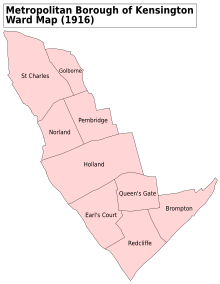
1918–1974: The Royal Borough of Kensington wards of Golborne, Norland, Pembridge, and St Charles.
| Kensington North | |
|---|---|
| Former borough constituency for the House of Commons | |
| 1885–February 1974 | |
| Seats | One |
| Created from | Chelsea |
| Replaced by | Kensington |
Kensington North was a parliamentary constituency centred on the Kensington district of west London. It returned one Member of Parliament (MP) to the House of Commons of the Parliament of the United Kingdom.
The constituency was created for the 1885 general election, and abolished for the February 1974 general election.




1918–1974: The Royal Borough of Kensington wards of Golborne, Norland, Pembridge, and St Charles.
| Party | Candidate | Votes | % | ±% | |
|---|---|---|---|---|---|
| Conservative | Roper Lethbridge | 3,619 | 54.6 | ||
| Liberal | Joseph Bottomley Firth | 3,011 | 45.4 | ||
| Majority | 608 | 9.2 | |||
| Turnout | 6,630 | 79.9 | |||
| Registered electors | 8,297 | ||||
| Conservative win (new seat) | |||||
| Party | Candidate | Votes | % | ±% | |
|---|---|---|---|---|---|
| Conservative | Roper Lethbridge | 3,394 | 58.1 | +3.5 | |
| Liberal | Edmund Routledge | 2,443 | 41.9 | −3.5 | |
| Majority | 951 | 16.2 | +7.0 | ||
| Turnout | 5,837 | 70.4 | −9.5 | ||
| Registered electors | 8,297 | ||||
| Conservative hold | Swing | +3.5 | |||
| Party | Candidate | Votes | % | ±% | |
|---|---|---|---|---|---|
| Liberal | Frederick Frye | 3,503 | 51.5 | +9.6 | |
| Conservative | William Edward Thompson Sharpe | 3,293 | 48.5 | −9.6 | |
| Majority | 210 | 3.0 | N/A | ||
| Turnout | 6,796 | 75.4 | +5.0 | ||
| Registered electors | 9,017 | ||||
| Liberal gain from Conservative | Swing | +9.6 | |||
| Party | Candidate | Votes | % | ±% | |
|---|---|---|---|---|---|
| Conservative | William Edward Thompson Sharpe | 3,829 | 56.8 | +8.3 | |
| Liberal | Frederick Frye | 2,913 | 43.2 | −8.3 | |
| Majority | 916 | 13.6 | N/A | ||
| Turnout | 6,742 | 71.1 | −4.3 | ||
| Registered electors | 9,482 | ||||
| Conservative gain from Liberal | Swing | +8.3 | |||
| Party | Candidate | Votes | % | ±% | |
|---|---|---|---|---|---|
| Conservative | William Edward Thompson Sharpe | 3,257 | 56.3 | −0.5 | |
| Liberal | Rufus Isaacs | 2,527 | 43.7 | +0.5 | |
| Majority | 730 | 12.6 | −1.0 | ||
| Turnout | 5,784 | 62.0 | −9.1 | ||
| Registered electors | 9,323 | ||||
| Conservative hold | Swing | −0.5 | |||

| Party | Candidate | Votes | % | ±% | |
|---|---|---|---|---|---|
| Liberal | Henry Yorke Stanger | 4,416 | 56.8 | +13.1 | |
| Conservative | Ellis Hume-Williams | 3,358 | 43.2 | −13.1 | |
| Majority | 1,058 | 13.6 | N/A | ||
| Turnout | 7,774 | 75.7 | +13.7 | ||
| Registered electors | 10,270 | ||||
| Liberal gain from Conservative | Swing | +13.1 | |||
| Party | Candidate | Votes | % | ±% | |
|---|---|---|---|---|---|
| Conservative | Alan Burgoyne | 4,611 | 53.1 | +9.9 | |
| Liberal | Henry Robson | 4079 | 46.9 | −9.9 | |
| Majority | 532 | 6.2 | N/A | ||
| Turnout | 10,100 | 86.0 | +10.3 | ||
| Conservative gain from Liberal | Swing | ||||
| Party | Candidate | Votes | % | ±% | |
|---|---|---|---|---|---|
| Conservative | Alan Burgoyne | 4,223 | 54.7 | 1.6 | |
| Liberal | Frank Murray Carson | 3494 | 45.3 | −1.6 | |
| Majority | 729 | 9.4 | +3.2 | ||
| Turnout | 10,100 | 76.4 | −9.6 | ||
| Conservative hold | Swing | ||||
| Party | Candidate | Votes | % | ±% | |
|---|---|---|---|---|---|
| C | Unionist | Alan Burgoyne | 13,176 | 78.3 | +23.6 |
| Labour | William Joseph Jarrett | 3,653 | 21.7 | New | |
| Majority | 9,523 | 56.6 | +11.2 | ||
| Turnout | 38,045 | 44.2 | −32.2 | ||
| Unionist hold | Swing | ||||
| Cindicates candidate endorsed by the coalition government. | |||||
| Party | Candidate | Votes | % | ±% | |
|---|---|---|---|---|---|
| Unionist | Percy George Gates | 12,328 | 53.1 | −25.2 | |
| Labour | William Joseph Jarrett | 6,225 | 26.8 | +5.1 | |
| Liberal | Charles William Hayward | 4,666 | 20.1 | New | |
| Majority | 6,103 | 26.3 | −30.3 | ||
| Turnout | 42,328 | 54.9 | +10.7 | ||
| Unionist hold | Swing | -15.2 | |||
| Party | Candidate | Votes | % | ±% | |
|---|---|---|---|---|---|
| Unionist | Percy George Gates | 9,458 | 39.4 | −13.7 | |
| Labour | William Joseph Jarrett | 8,888 | 37.0 | +10.2 | |
| Liberal | Leonard Stein | 5,672 | 23.6 | +3.5 | |
| Majority | 570 | 2.4 | −23.9 | ||
| Turnout | 43,050 | 55.8 | +0.9 | ||
| Unionist hold | Swing | -12.0 | |||
| Party | Candidate | Votes | % | ±% | |
|---|---|---|---|---|---|
| Conservative | Percy George Gates | 16,255 | 53.0 | +13.6 | |
| Labour | Fielding West | 14,401 | 47.0 | +10.0 | |
| Majority | 1,854 | 6.0 | +3.6 | ||
| Turnout | 44,015 | 69.6 | +13.8 | ||
| Conservative hold | Swing | +3.6 | |||
| Party | Candidate | Votes | % | ±% | |
|---|---|---|---|---|---|
| Labour | Fielding West | 19,701 | 48.4 | +1.4 | |
| Unionist | Percy George Gates | 15,511 | 38.1 | −14.9 | |
| Liberal | Frances Stewart | 5,516 | 13.5 | New | |
| Majority | 4,190 | 10.3 | N/A | ||
| Turnout | 59,500 | 68.5 | −1.1 | ||
| Labour gain from Unionist | Swing | +8.1 | |||
| Party | Candidate | Votes | % | ±% | |
|---|---|---|---|---|---|
| Conservative | James Duncan | 27,860 | 63.7 | +25.6 | |
| Labour | Fielding West | 15,843 | 36.3 | −12.1 | |
| Majority | 12,017 | 27.4 | N/A | ||
| Turnout | 60,821 | 71.9 | +3.4 | ||
| Conservative gain from Labour | Swing | +18.8 | |||
| Party | Candidate | Votes | % | ±% | |
|---|---|---|---|---|---|
| Conservative | James Duncan | 18,907 | 53.2 | −10.5 | |
| Labour | Frank Carter | 15,309 | 43.1 | +6.8 | |
| Liberal | John Seymour Spon | 1,323 | 3.7 | New | |
| Majority | 3,598 | 10.1 | −17.3 | ||
| Turnout | 58,691 | 60.6 | −11.3 | ||
| Conservative hold | Swing | -8.7 | |||
| Party | Candidate | Votes | % | ±% | |
|---|---|---|---|---|---|
| Labour | George Rogers | 16,838 | 56.6 | +13.5 | |
| Conservative | James Duncan | 10,699 | 36.0 | −17.2 | |
| Liberal | John Richard Colclough | 2,212 | 7.4 | +3.7 | |
| Majority | 6,139 | 20.6 | N/A | ||
| Turnout | 42,365 | 70.2 | +9.6 | ||
| Labour gain from Conservative | Swing | +15.4 | |||
| Party | Candidate | Votes | % | ±% | |
|---|---|---|---|---|---|
| Labour | George Rogers | 21,615 | 50.65 | ||
| Conservative | Leonard Caplan | 17,991 | 42.15 | ||
| Liberal | Robert Rufus Carey Evans | 2,522 | 5.91 | ||
| Communist | M.J. Eyre | 551 | 1.29 | New | |
| Majority | 3,624 | 8.50 | |||
| Turnout | 54,480 | 78.34 | |||
| Labour hold | Swing | ||||
| Party | Candidate | Votes | % | ±% | |
|---|---|---|---|---|---|
| Labour | George Rogers | 22,686 | 52.99 | ||
| Conservative | Leonard Caplan | 18,543 | 43.31 | ||
| Liberal | Anthony Graeme Gamble | 1,583 | 3.70 | ||
| Majority | 4,143 | 9.68 | |||
| Turnout | 54,083 | 79.16 | |||
| Labour hold | Swing | ||||
| Party | Candidate | Votes | % | ±% | |
|---|---|---|---|---|---|
| Labour | George Rogers | 20,226 | 53.92 | ||
| Conservative | Robert Bulbrook | 17,283 | 46.08 | ||
| Majority | 2,943 | 7.84 | |||
| Turnout | 53,789 | 69.73 | |||
| Labour hold | Swing | ||||
| Party | Candidate | Votes | % | ±% | |
|---|---|---|---|---|---|
| Labour | George Rogers | 14,925 | 42.75 | −11.17 | |
| Conservative | Robert Bulbrook | 14,048 | 40.24 | −5.84 | |
| Liberal | Michael Louis Hydleman | 3,118 | 8.93 | New | |
| Union Movement | Oswald Mosley | 2,821 | 8.08 | New | |
| Majority | 877 | 2.51 | −5.33 | ||
| Turnout | 34,912 | 67.83 | −1.90 | ||
| Labour hold | Swing | −2.7 | |||
| Party | Candidate | Votes | % | ±% | |
|---|---|---|---|---|---|
| Labour | George Rogers | 15,283 | 49.50 | ||
| Conservative | Andrew Bowden | 12,771 | 41.37 | ||
| Liberal | Yvonne C Richardson | 2,819 | 9.13 | ||
| Majority | 2,512 | 8.13 | |||
| Turnout | 30,873 | 61.32 | |||
| Labour hold | Swing | ||||
| Party | Candidate | Votes | % | ±% | |
|---|---|---|---|---|---|
| Labour | George Rogers | 16,012 | 54.79 | ||
| Conservative | Leon Brittan | 10,749 | 36.78 | ||
| Liberal | Anthony Clive S Thomas | 2,462 | 8.42 | ||
| Majority | 5,263 | 18.01 | |||
| Turnout | 29,223 | 62.07 | |||
| Labour hold | Swing | ||||
| Party | Candidate | Votes | % | ±% | |
|---|---|---|---|---|---|
| Labour | Bruce Douglas-Mann | 13,175 | 52.8 | −2.0 | |
| Conservative | Leon Brittan | 9,792 | 39.2 | +2.4 | |
| Liberal | Patrick Spencer | 1,990 | 7.9 | −0.5 | |
| Majority | 3,383 | 13.6 | −4.4 | ||
| Turnout | 24,957 | 57.4 | −4.7 | ||
| Labour hold | Swing | ||||
Edinburgh and St Andrews Universities was a university constituency represented in the House of Commons of the Parliament of the United Kingdom from 1868 until 1918. It was merged with the Glasgow and Aberdeen Universities constituency to form the Combined Scottish Universities constituency.
Wick Burghs, sometimes known as Northern Burghs, was a constituency of the House of Commons of the Parliament of the United Kingdom from 1832 to 1918. It elected one Member of Parliament (MP) by the first past the post voting system.
Wigtownshire, was a Scottish constituency of the House of Commons of the Parliament of Great Britain from 1708 to 1801 and of the Parliament of the United Kingdom from 1801 to 1918. It was represented by one Member of Parliament.

Fulham was a borough constituency centred on the London district of Fulham. It was represented in the House of Commons of the Parliament of the United Kingdom from 1885 until 1918 and from 1955 to 1997.
Birmingham East was a parliamentary constituency in the city of Birmingham, England. It returned one Member of Parliament (MP) to the House of Commons of the Parliament of the United Kingdom, elected by the first-past-the-post voting system.

Oswestry was a United Kingdom Parliamentary constituency. It was a constituency of the House of Commons of the Parliament of the United Kingdom from 1885 to 1983, when it was renamed North Shropshire. It elected one Member of Parliament (MP) by the first past the post method of election.
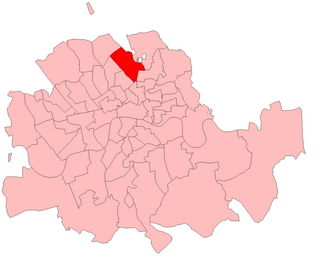
Islington East was a constituency which returned one Member of Parliament (MP) to the House of Commons of the Parliament of the United Kingdom from 1885, until it was abolished for the February 1974 general election.

Clapham was a borough constituency in South London which returned one Member of Parliament (MP) to the House of Commons of the UK Parliament. It was created in time for the 1885 general election then altered in periodic national boundary reviews, principally in 1918, and abolished before the February 1974 general election. In its early years the seat was officially named Battersea and Clapham Parliamentary Borough: No. 2—The Clapham Division.
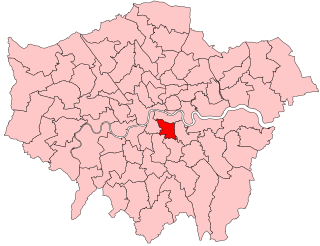
Peckham is a borough constituency in South London which returns one Member of Parliament (MP) to the House of Commons of the Parliament of the United Kingdom. Elections are held using the first-past-the-post voting system.
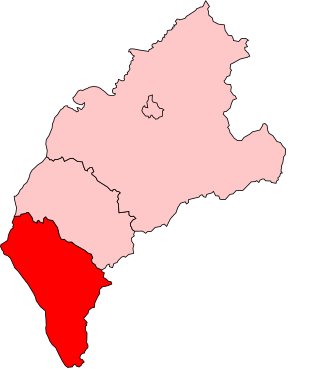
Whitehaven was a constituency centred on the town of Whitehaven in Cumberland, which returned one Member of Parliament (MP) to the House of Commons of the Parliament of the United Kingdom.

Salford North was a parliamentary constituency in the City of Salford in Greater Manchester from 1885 until 1950. It returned one Member of Parliament (MP) to the House of Commons of the Parliament of the United Kingdom.

Hackney Central was a borough constituency in what was then the Metropolitan Borough of Hackney, in London. It returned one Member of Parliament (MP) to the House of Commons of the Parliament of the United Kingdom.
Holderness was a parliamentary constituency centred on the Holderness area of the East Riding of Yorkshire. It returned one Member of Parliament (MP) to the House of Commons of the Parliament of the United Kingdom.

Deptford was a parliamentary constituency centred on the Deptford district of South London. It returned one Member of Parliament (MP) to the House of Commons of the Parliament of the United Kingdom.

Kensington South was a parliamentary constituency centred on the Kensington district of west London. It returned one Member of Parliament (MP) to the House of Commons of the Parliament of the United Kingdom.

Camberwell North was a borough constituency located in the Metropolitan Borough of Camberwell, in South London. It returned one Member of Parliament (MP) to the House of Commons of the Parliament of the United Kingdom. The constituency was created for the 1885 general election, and abolished for the 1950 general election.
Islington South was a parliamentary constituency in the Metropolitan Borough of Islington in North London. It returned one Member of Parliament (MP) to the House of Commons of the Parliament of the United Kingdom.
Islington West was a borough constituency in the Metropolitan Borough of Islington, in North London.

Strand was a parliamentary constituency in the Strand district of the City of Westminster. It returned one Member of Parliament (MP) to the House of Commons of the Parliament of the United Kingdom.
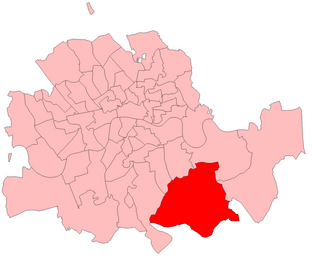
Lewisham was a borough constituency in the Lewisham district of London. It returned one Member of Parliament (MP) to the House of Commons of the Parliament of the United Kingdom, elected by the first past the post system.